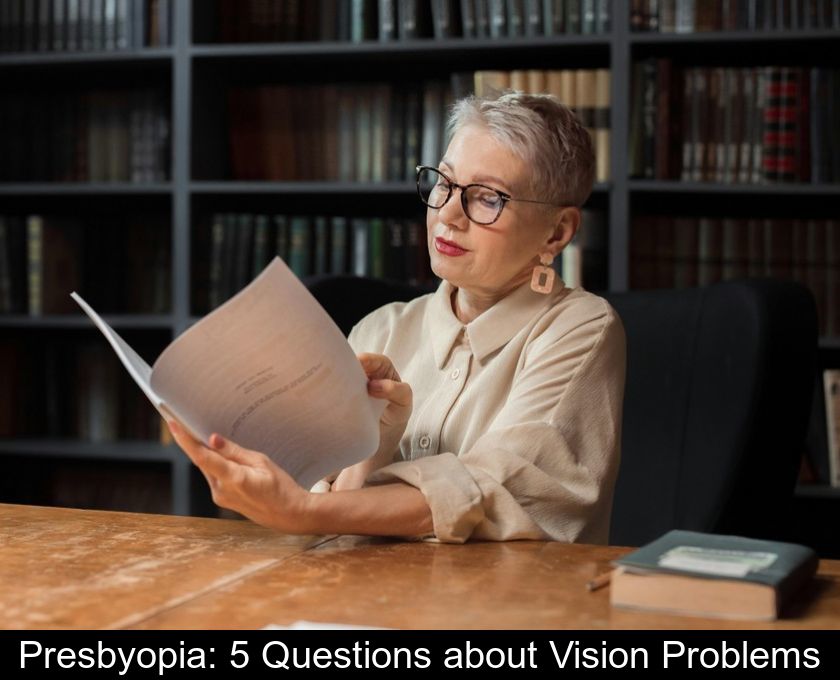Presbyopia: 5 Questions About Vision Problems
Are you struggling to read fine print, even when holding the text at a distance? You may be suffering from presbyopia, like 600,000 new individuals each year. Here are the causes of this vision problem and the various existing solutions to correct it.
At what age does one become presbyopic?
It is rare to escape presbyopia from the age of forty. The physiological age for this vision problem is between 45 and 50 years old. The term "presbyopia" comes from the Greek word presbys, meaning "old man." This etymology highlights the fact that this visual impairment is linked to the normal aging of the eye.
However, the age at which presbyopia is perceived by the patient can vary depending on other vision defects: earlier in hyperopes and later in myopes.
Note: Myopes may delay the switch to progressive lenses because their myopia can compensate for early presbyopia. They generally manage to read up close until their fifties.
The progression of this visual disorder is rapid at first, and corrective lenses need to be changed on average every two years between the ages of 45 and 50. Vision then stabilizes around the age of 60.
What are the symptoms of presbyopia?
The symptoms of presbyopia generally appear around the age of 45:
• difficulty reading small print.
• trouble with close-up work.
• need to hold text farther away to see it clearly.
• need for better lighting to see.
What are the causes of presbyopia?
The culprit behind presbyopia is the lens, the part of our eyes that acts as a sort of natural lens located inside the eye, behind the pupil.
The lens handles focusing, similar to a camera:
• by contracting, it allows us to see clearly up close
• by relaxing, it allows us to see clearly at a distance.
Presbyopia is not a disease but a sign of aging in the lens. As we age, the lens thickens and loses its elasticity. Its ability to accommodate decreases, especially when reading. This is why the distance at which one can read clearly increases.
Does eye yoga delay presbyopia?
Eye gymnastics and eye yoga do not really allow to delay or cure vision disorders, such as myopia or presbyopia.
However, such exercises can help alleviate visual fatigue in some presbyopic patients.
The best solution for eye fatigue is to make an appointment with an ophthalmologist for a check-up. This specialist can detect a vision defect that the patient has not noticed or that is poorly corrected.
5- How to correct presbyopia?
There are several solutions to achieve clear vision at all distances. Presbyopia can be easily corrected with the use of glasses.
• Simple reading glasses only correct near vision, at about 40 cm. To see far away, one must then look over their glasses.
• Mid-distance lenses allow for clear vision up close and in a wider field of view.
• Progressive lenses offer the most complete and comfortable solution. They provide clear vision at all distances.
Note: Progressive lenses are particularly useful for correcting multiple visual impairments (presbyopia + Myopia or hyperopia or astigmatism) in a single lens. But they are also suitable for people who are only presbyopic. It takes a few hours to a few days to get used to them. Adaptation to progressive lenses is easier if one does not wait too long to correct their vision.
For more discretion, you can opt for progressive contact lenses. In this case, the center of the lenses corrects near vision and the periphery corrects far vision. Your brain then has to adapt and learn to select the right focus.
As with other corrections, you have the choice between lenses with a lifespan of a day or several months. Social security reimburses contact lenses in the same way as glasses, and more and more mutual insurance companies cover part of the cost.
Finally, one can also resort to laser surgery (presby-lasik) or the insertion of a progressive implant. Presbyopia surgery is considered cosmetic surgery. Therefore, it is not covered by insurance. The cost ranges between 3000€ and 4000€ for both eyes.





